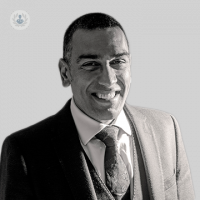Chiari malformations: what are they and why do they occur?
Escrito por:Our brains are the control centres of our bodies. Signals travel to and from the brain via the nervous system, but if these signals are blocked or impaired, it can have serious consequences. Chiari malformations are conditions that result in brain tissue extending down into the spinal canal, creating pressure, which can interfere with signals going to and from the brain. Mr Sanj Bassi, a Chiari expert at London Neurosurgery Partnership, explains these conditions.

What are Chiari malformations?
Chiari malformations are abnormalities in the base of the skull and the bottom of the brain, where some of the brain tissue (the cerebellar tonsils, cerebellum, brain stem and/or part of the fourth ventricle) extends into the spinal canal. This can occur due to the skull being unusually small or misshapen, which pushes the brain tissue down.
Chiari malformations can lead to a number of problems, including:
- Blockage of signals from the brain to the rest of the body
- Build-up of cerebrospinal fluid in the brain or spinal cord
- Increased pressure on the brain stem and spinal cord – this can lead to further neurological problems.
However, in many cases, Chiari malformations cause no symptoms and the condition may go unnoticed, never requiring treatment. Sometimes, these asymptomatic malformations are discovered when the patient undergoes an imaging scan for another reason.
Types of Chiari malformation
Doctors divide Chiari malformations into either three or four types. Chiari I and II are the most common.
Chiari I:
Chiari I malformations are often asymptomatic, but if they produce symptoms, they usually manifest in late childhood or early adulthood. The back part of the skull is either too small or is misshapen, forcing the lower part of the brain (the cerebellar tonsils) into the upper part of the spinal canal.
Symptoms include:
- Impulse headache – this is caused by the increased brain pressure and may be associated with coughing and sneezing
- Balance problems
- Visual problems
- Poor hand-eye coordination (if associated with a spinal cyst)
- Difficulty walking
- Difficulty swallowing
Chiari II:
Chiari II malformations involve an open myelomeningocele or spina bifida (the backbone and spinal canal do not close properly during development in the womb). Chiari II often presents at birth. Symptoms include:
- Arm weakness
- Changes in breathing
- Trouble swallowing
- Rapid downward eye movements
Chiari III:
Less common but more severe than the previous two types, in Chiari III there is an opening in the skull (encephalocele) through which the brain protrudes. It is usually diagnosed at birth or even while the baby is still in the womb, and can cause a number of neurological problems.
How do you treat a Chiari malformation?
Treatment depends on the type of Chiari malformation and the symptoms.
If there are no symptoms and the condition isn’t causing problems for the patient, it will probably not need treatment, but should be monitored with regular check-ups and MRI scans.
Symptomatic Chiari malformations usually require surgery. For Chiari I, first the hydrocephalus (build-up of cerebrospinal fluid in the brain) must be treated. Then a posterior fossa decompression may be done – this removes a small amount of bone from the back of the skull, allowing the brain more room. Sometimes, a small section of bone from the top of the spine may also need to be removed to give the spinal cord more space. In some cases, the surgeon may thin the covering of the brain and spinal cord (dura). All of these procedures are aimed at freeing the brain and spinal cord from compression.
There are a risks and complications with all surgical procedures and your consultant will discuss these and all your options with you beforehand to decide if surgery is the best option.


